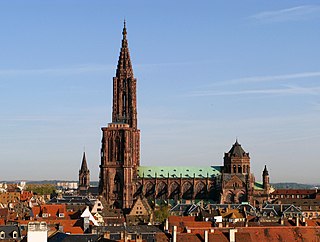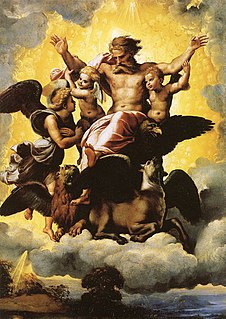The Strasbourg papyrus is a papyrus made of six fragments on a single leaf written in Greek and conserved at the Strasbourg National University Library, cataloged Gr. 254. It was first edited in 1928. [1] The Strasbourg papyrus contains an ancient Christian prayer, probably an Anaphora, similar to the first part of the Alexandrine Anaphora of Saint Mark (later known also as Anaphora of Saint Cyril). The Papyrus was probably written in the fourth or fifth century, but it may present an older text, resulting to be one of the older Eucharistic Prayer known.

Papyrus is a material similar to thick paper that was used in ancient times as a writing surface. It was made from the pith of the papyrus plant, Cyperus papyrus, a wetland sedge. Papyrus can also refer to a document written on sheets of such material, joined together side by side and rolled up into a scroll, an early form of a book.
Koine Greek, also known as Alexandrian dialect, common Attic, Hellenistic or Biblical Greek, was the common supra-regional form of Greek spoken and written during the Hellenistic period, the Roman Empire, and the early Byzantine Empire, or late antiquity. It evolved from the spread of Greek following the conquests of Alexander the Great in the fourth century BC, and served as the lingua franca of much of the Mediterranean region and the Middle East during the following centuries. It was based mainly on Attic and related Ionic speech forms, with various admixtures brought about through dialect levelling with other varieties.

Strasbourg is the capital and largest city of the Grand Est region of France and is the official seat of the European Parliament. Located at the border with Germany in the historic region of Alsace, it is the capital of the Bas-Rhin department. In 2016, the city proper had 279,284 inhabitants and both the Eurométropole de Strasbourg and the Arrondissement of Strasbourg had 491,409 inhabitants. Strasbourg's metropolitan area had a population of 785,839 in 2015, making it the ninth largest metro area in France and home to 13% of the Grand Est region's inhabitants. The transnational Eurodistrict Strasbourg-Ortenau had a population of 915,000 inhabitants in 2014.
Since the 1970s many scholars started to think that this prayer is in itself a complete anaphora, [2] [3] [4] even if this assumption has been challenged after the publication of the Barcelona Papyrus. [5] The structure of such a prayer is very different from the thanksgiving over the wine and bread as found in chapter 9 and 10 of the Didache. Actually there is not even a mention of any food; nor does it present the Sanctus, nor an anamnesis nor an epiclesis and not even the Words of Institution. This text is anyway considered to include the base structure that we can find later in many other famous anaphoras.

The Anaphora is the most solemn part of the Divine Liturgy, or the Holy Sacrifice of the Mass, during which the offerings of bread and wine are consecrated as the body and blood of Christ. This is the usual name for this part of the Liturgy in Greek-speaking Eastern Christianity. In western Christian traditions which have a comparable rite, the Anaphora is more often called the Roman Canon in the Latin liturgy, or the Eucharistic Prayer for the three additional modern anaphoras. When the Roman Rite had a single Eucharistic Prayer, it was called the Canon of the Mass.
The Barcelona Papyrus is a 4th century papyrus codex, coming from Egypt and cataloged as P.Monts.Roca inv.128-178. It is the oldest liturgical manuscript containing a complete anaphora.

The Didache, also known as The Teaching of the Twelve Apostles, is a brief anonymous early Christian treatise, dated by most modern scholars to the first century. The first line of this treatise is "The teaching of the Lord to the Gentiles by the twelve apostles". The text, parts of which constitute the oldest extant written catechism, has three main sections dealing with Christian ethics, rituals such as baptism and Eucharist, and Church organization. The opening chapters describe the virtuous Way of Life and the wicked Way of Death. The Lord's Prayer is included in full. Baptism is by immersion, or by affusion if immersion is not practical. Fasting is ordered for Wednesdays and Fridays. Two primitive Eucharistic prayers are given. Church organization was at an early stage of development. Itinerant apostles and prophets are important, serving as "chief priests" and possibly celebrating the Eucharist. Meanwhile, local bishops and deacons also have authority and seem to be taking the place of the itinerant ministry. The Didache is considered the first example of the genre of Church Orders. The Didache reveals how Jewish Christians saw themselves and how they adapted their practice for Gentile Christians. The Didache is similar in several ways to the Gospel of Matthew, perhaps because both texts originated in similar communities. The opening chapters, which also appear in other early Christian texts, are likely derived from an earlier Jewish source.





